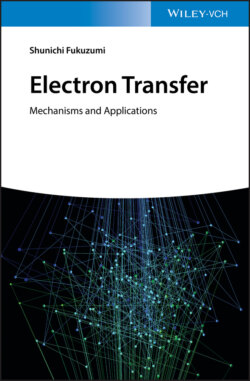Читать книгу Electron Transfer - Shunichi Fukuzumi - Страница 10
2 Marcus Theory of Electron Transfer
ОглавлениеThe dependence of rate constants of electron transfer on the driving force of electron transfer is well analyzed on the basis of the Franck–Condon principle (vide supra) by the Marcus theory of electron transfer, which provides basic principles to analyze the rate constant of electron transfer quantitatively [6]. According to the Marcus theory of electron transfer [6], the rate constant of nonadiabatic intramolecular electron transfer (kET) is given by Eq. (2.1):
(2.1)
where V is the electronic coupling matrix element, h is the Planck constant, T is the absolute temperature, ΔGET is the free energy change of electron transfer, and λ is the reorganization energy of electron transfer [6]. The ΔGET values are determined from the one‐electron oxidation potentials (Eox) of electron donors (D) and the one‐electron reduction potentials (Ered) of electron acceptors by Eq. (2.2):
(2.2)
where e is elementary charge. According to Eq. (2.1), the logarithm of the electron‐transfer rate constant (log kET) is related parabolically to the driving force of electron transfer from electron donors to acceptors (−ΔGET) and the reorganization energy (λ) of electron transfer, that is, the energy required to structurally reorganize the donor, acceptor, and their solvation spheres upon electron transfer [6].
When the magnitude of the driving force of electron transfer becomes the same as the reorganization energy (−ΔGET = λ), the electron‐transfer rate reaches a maximum and is basically controlled by the magnitude of electronic coupling (V) between the donor and acceptor moieties (Eq. (2.1)). Upon passing this thermodynamic maximum, the highly exothermic region of the parabola (−ΔGET > λ) is entered, in which an additional increase of the driving force results in an actual slowdown of the electron‐transfer rate, due to an increasingly poor vibrational overlap of the product and reactant wave functions. This highly exergonic range is generally referred to as the Marcus inverted region [6–8,28,29]. In such a case, the magnitude of the reorganization energy is the key parameter to control the electron‐transfer process. The smaller the reorganization energy, the faster is the forward photoinduced charge‐separation (CS) process, but the charge‐recombination (CR) process becomes slower when the driving force for back electron transfer (–ΔGET) is larger than the reorganization energy (λ) of electron transfer as shown in Figure 2.1. Among the key parameters that govern electron‐transfer reactions (V, ΔGET, and λ), the reorganization energy (λ) imposes the most important impact. The primary electron‐transfer processes of photosynthesis are, for example, characterized by an extremely small reorganization energy (λ ∼ 0.2 eV), attained by the protein environment. This aspect is essential to achieving ultrafast charge separation and retarding the energy‐wasting charge recombination, which is highly exergonic (−ΔG = 1.2 eV) [11–15]. Thus, the components of artificial photosynthesis, which are not necessarily natural components in photosynthesis, must have small λ values of electron transfer.
Figure 2.1 (a) Schematic diagram of photoinduced electron transfer of an electron donor–acceptor (D–A) dyad. (b) Driving force dependence of log kET with different λ values (for the meaning of λ, see text).
